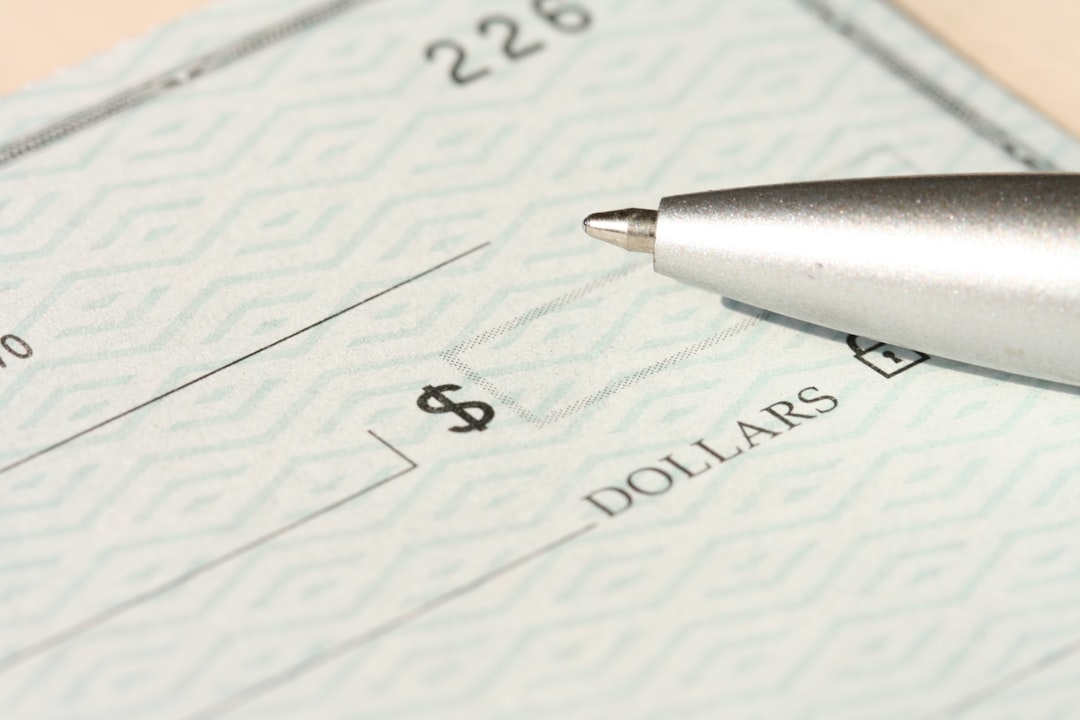The cost of playing hockey can be significant, and for some families, it’s necessary to take out a personal loan in order to cover the costs. One such example is the case of John Smith, who had recently been accepted into a high-level travel team but was struggling with how he would afford the associated fees. After researching his options and weighing all factors carefully, John ultimately decided that taking out a personal loan was his best course of action.
Personal loans are an increasingly popular way to finance expensive activities like hockey or other sports. It allows individuals to borrow funds without having to put up collateral or pay extra interest rates on their credit cards. They also have more flexible repayment terms than traditional bank loans which makes them attractive when compared to other solutions.
When considering whether taking out a personal loan could help you manage your hockey-related expenses, there are several important things you need to know before making your decision. This article will go over what information you should consider when deciding if this type of financing is right for you, including potential risks and benefits as well as tips for selecting the best option available.
1) Overview of Hockey-Related Expenses
Hockey-related expenses can be costly for amateur and competitive players alike. Take the example of Jane, a 15 year old girl who dreams of playing in college one day. In order to make that dream come true, she needs to attend hockey camps, purchase equipment and secure coaching resources; all things not easily attainable on her family’s limited budget. Fortunately, there are several options available which allow individuals such as Jane to cover these costs: personal loans.
Personal loans provide an efficient way to finance hockey-related expenses like purchasing skating lessons or even paying tournament fees. These types of loans typically have fixed interest rates and repayment periods ranging from 12–60 months depending on the lender’s requirements. Benefits of taking out this type of loan include:
- Low monthly payments
- Simple application process
- Flexible terms
Taking out a personal loan is often seen as a viable option for those looking to finance their hockey ambitions without relying solely on savings or other sources of income.
For many families with children involved in sports activities, securing additional funds through a personal loan is just what they need in order to give them peace of mind when it comes to covering related expenses. With careful planning and research into lenders offering favorable terms and conditions, parents can ensure that their child has access to the best possible opportunities without having to worry about how they will pay for them. By understanding the different financial options available, individuals like Jane can benefit from assistance provided by personal loan lenders while still achieving their goal of playing at a higher level within the sport. From here we move onto the next section discussing Types of Loans Available.
2) Types of Loans Available
When it comes to financing hockey-related expenses, there are a variety of loan options available. Take the case of Jack, an aspiring professional hockey player who needs additional funding for training and equipment. He has considered taking out a personal loan to cover these costs but is unsure what type of loan would be best suited for him. In this section, we will explore the different types of loans that can be used to finance hockey-related expenses:
The first option is a secured loan, which requires collateral such as property or other valuable assets in order to secure the loan. This provides lenders with more assurance that they will get their money back in case of default on payments by the borrower. Secured loans often come with lower interest rates than unsecured loans due to their added security. However, if Jack does not have any suitable collateral he may not qualify for a secured loan.
Another route Jack could take is obtaining an unsecured personal loan from his bank or credit union. Unsecured loans do not require collateral and instead rely on factors like credit score and debt-to-income ratio when determining eligibility and interest rate. The main benefits are that approval time is usually quicker than with a secured loan and there’s no risk of losing your home or car if you don’t make timely payments; however, unsecured loans tend to carry higher interest rates than secured ones since they present greater risks for lenders.
Finally, peer-to-peer lending platforms provide another alternative source for borrowing funds online without having to go through traditional banks or financial institutions. These platforms allow individual borrowers to receive funding directly from investors looking for returns on their investments. Although these online marketplaces typically charge higher fees compared to traditional banking institutions, they offer flexibility in terms of repayment periods and access to larger amounts of capital faster than most other sources due to minimal paperwork requirements and quick turnaround times when applying for funds. Some key advantages of using peer-to-peer lending include:
- Lower Interest Rates – Most P2P lenders offer competitive interest rates compared to traditional banks or credit unions
- Flexible Repayment Terms – Borrowers can choose between weekly or monthly payment plans based on their budgeting needs
- Quick Access To Funds – Loans can be approved within days rather than weeks or months so borrowing happens quickly and easily
By exploring all available options thoroughly before committing himself financially, Jack ensures that he finds the best fit for covering his hockey related expenses while also managing his overall financial situation responsibly over the long run. With this knowledge in hand, he will now be better equipped to determine whether a personal loan is right for him given its potential benefits as well as drawbacks associated with taking on any kind of debt obligation.
3) Benefits and Drawbacks of Personal Loans for Hockey-Related Expenses
Taking out a personal loan for hockey-related expenses is not an uncommon practice. For example, parents of aspiring professional ice hockey players may take out a loan in order to cover costs related to travel, equipment and training. There are various benefits and drawbacks associated with taking such loans that should be considered before making the decision.
The primary benefit of taking out personal loans for hockey-related expenses is the flexibility they provide when it comes to repayment. These loans can often come with lower interest rates than other forms of financing and some lenders offer payment plans tailored to suit individual needs. Additionally, these loans do not require collateral or any form of security deposit – meaning there’s no risk of losing valuable assets in case of nonpayment. In terms of advantages specific to hockey-related expenses, having access to this type of funding means that families have more options when it comes to giving their children the opportunity to pursue their dreams without worrying about how they will pay for them later on down the line.
On the flip side, personal loans also carry certain risks with them which must be taken into account when weighing up whether or not it makes sense financially:
- Repayment periods are usually fixed so if you’re unable to make payments on time then this could lead to additional fees being charged;
- Interest rates can still add up over time depending on your lender;
- Your credit score could be affected if payments aren’t made as agreed upon initially.
Although taking out a loan for hockey-related expenses carries its own unique set of pros and cons, assessing these factors carefully beforehand can help ensure that the right decisions are made regarding finances. With proper budgeting and due diligence prior to signing any agreements, individuals can confidently move forward knowing they have found a way to fund their ambitions while minimizing financial risk at the same time.
4) Qualifying Criteria for Hockey-Related Loans
Taking out a personal loan for hockey-related expenses is an increasingly popular option among those who are passionate about the sport and need financial assistance to reach their goals. For instance, Lillian, a budding professional ice hockey player in Minnesota, took out a personal loan to cover her equipment and tournament fees so that she could pursue her dream of becoming a pro.
The benefits of taking out a personal loan for hockey-related expenses include:
- Accessible – Most lenders will not require any collateral or credit check, making it easier for applicants with bad credit histories to qualify.
- Flexibility – Borrowers can choose from several different repayment options depending on their needs and budget.
- Speed – Personal loans typically take less time to process than other forms of financing, such as bank loans or lines of credit.
Though these advantages may make taking out a personal loan seem like an attractive option, there are also drawbacks that should be considered. Namely, most personal loans come with higher interest rates compared to other types of financing; this means that borrowers may end up paying more in the long run if they’re unable to pay back the loan quickly enough. Additionally, some lenders will add additional fees onto the loan amount if they deem the borrower “high risk” due to poor credit history or lack of income verification documents.
In order to qualify for a personal loan for hockey-related expenses, borrowers must meet certain criteria set by the lender. These requirements vary between lenders but generally include proof of identification (such as driver’s license), proof of income (bank statements/pay stubs) and evidence that you have sufficient funds available each month to make regular payments towards your debt obligation without defaulting on them. Furthermore, many lenders may also require prospective borrowers to provide information regarding their employment history and even past payment records with other creditors before approving them for a loan.
Given all these considerations – from the potential benefits and drawbacks associated with taking out a personal loan for hockey-related expenses to qualifying criteria – shopping around carefully is key when looking for the best deal possible.
5) Shopping for the Best Personal Loan for Hockey-Related Expenses
Having discussed the common criteria that lenders look for when considering a hockey-related loan application, it is now time to turn our attention towards shopping for the best personal loan. As with any major purchase decision, researching your options is an important step in finding the most suitable product. For example, consider John and Sarah who are both avid hockey players looking to finance their respective teams’ expenses through a loan.
When choosing which lender to work with, there are some key factors they should take into consideration:
- Interest rates—the lower the better as this will save money over the life of the loan;
- Repayment terms – flexible repayment terms can make managing finances easier;
- Extras or incentives – such as discounts on products or services related to hockey.
John and Sarah must research each potential lender thoroughly before making a final decision. It may be helpful to speak directly with representatives from various companies so that questions about interest rates and other details can be answered face-to-face. Additionally, many online resources exist that offer comparisons between different lenders based on location, credit score requirements and more. This allows them to quickly cross off certain options if necessary. When all is said and done though, selecting one particular lender requires careful consideration of available options in order to ensure maximum benefit down the road.
The importance of carefully reviewing all offers cannot be understated because even small differences in price can add up over time and significantly impact how much has been spent by the end of the loan term. Furthermore, taking advantage of any extras provided by specific lenders could also provide significant savings depending on what type of incentive was offered. Therefore, doing proper research ahead of time can pay big dividends later on when making payments becomes due monthly or weekly depending on the agreed upon schedule established at signing.
Frequently Asked Questions
) Are there any special tax benefits associated with taking out a personal loan for hockey-related expenses?
When taking out a personal loan for hockey-related expenses, there may be certain tax benefits associated with it. For instance, Mark Smith was able to use his loan towards purchasing new equipment and attending training camps in order to improve his skills as an ice hockey player. In addition, he was also able to take advantage of the following benefits:
- Tax deductions on interest payments made on the loan;
- A reduction in taxable income thanks to mortgage points or origination fees being included as part of the loan amount;
- Possible access to special government grants that are available only for those who have taken out a personal loan for sports-related activities.
These tax benefits can make taking out a personal loan for hockey-related expenses more attractive option than other forms of financing such as credit cards or traditional bank loans. Furthermore, depending on one’s individual situation, these advantages can potentially lower their overall cost of borrowing significantly. Additionally, many lenders will offer additional incentives such as reduced rates or extended repayment periods if they feel that it is beneficial to them. This means that borrowers should always do their research thoroughly before making any decisions regarding taking out a personal loan. By doing so, they can ensure that they receive all the possible advantages associated with this type of financing while still being mindful of their individual finances.
) What types of collateral are required to secure a loan for hockey-related expenses?
When considering taking out a personal loan for hockey-related expenses, one of the most important factors to consider is what type of collateral is required. For example, if someone wants to take out a loan in order to purchase new equipment or travel costs associated with playing competitively, they need to be aware that some lenders will require them to provide something as collateral for the loan.
Collateral can range from physical items such as jewelry or home equity loans, to intangible assets like stocks and bonds. The lender may also request the borrower put up real estate deeds or other forms of legal documents which give them ownership rights over their property until the debt has been repaid in full. It’s important for borrowers to understand all requirements before signing any agreement so they know exactly what kind of collateral they are obligated to provide.
The following list outlines three key points when it comes to understanding how collateral works:
- It provides additional security for both parties involved; this means that if the borrower fails to repay then the lender has legal recourse against them by seizing the pledged asset(s).
- Choosing an appropriate form of collateral can help reduce interest rates on certain types of loans because lenders view it as less risky than unsecured credit.
- Borrowers should always assess their own financial situation first before agreeing to anything that could threaten their long term stability and/or place too much pressure on their current finances.
By being aware of these considerations ahead of time, potential borrowers can make informed decisions about whether taking out a personal loan for hockey-related expenses is right for them and how best to secure it without putting themselves at risk financially in the future.
) Is there a maximum amount that can be borrowed for hockey-related expenses?
When it comes to borrowing money for hockey-related expenses, many people are unaware of the maximum amount they can take out. For instance, a professional hockey player who needs to cover travel costs might wonder if there is an upper limit on how much money he or she can borrow. It’s important to understand what types of loans are available and their associated limits before making any decisions about financing your hockey activities.
The first step in figuring out the maximum loan amount you can receive is determining which type of loan best fits your financial situation. Generally speaking, these loans fall into two categories: secured and unsecured. Secured loans involve collateral – usually property or other assets that serve as security in case you default on the loan – while unsecured loans don’t require any sort of collateral but often come with higher interest rates.
In addition to understanding the difference between secured and unsecured loans when it comes to hockey-related expenses, borrowers should also be aware of:
- The terms and conditions of each loan option (e.g., repayment periods)
- How credit scores may affect eligibility for certain types of loans
- The fees associated with borrowing money (including closing costs).
Knowing all this information will help anyone looking to finance their hockey activities make informed decisions when it comes time to choose a lender and negotiate terms. It’s also advisable to compare offers from different lenders so you know exactly what kind of options are available and at what price point so you can get the most bang for your buck!
) Can I use the funds from my loan for other sports-related activities outside of hockey?
When it comes to using personal loan funds for hockey-related expenses, borrowers may wonder if they can use the money for other sports activities. For example, a high school student who plans on joining the varsity hockey team in college might consider taking out a loan to pay for their equipment and travel costs.
Generally speaking, personal loans taken out for hockey-related purposes are not restricted specifically to those expenses. The borrower is free to use the funds as they see fit, although there are some important considerations:
1) Be sure that any additional sports activities would be feasible within your budget;
2) Make sure you understand all of the terms associated with your loan before making any decisions;
3) Keep track of your spending so that you don’t get overcharged or accumulate debt from interest payments.
It’s also worth noting that lenders often require repayment of such loans regardless of whether or not an individual actually uses them for hockey-related purchases. Therefore, it’s crucial to ensure that you have enough money saved up prior to taking out a loan and make sure you fully understand any restrictions placed upon its usage. Additionally, many financial institutions offer special programs designed specifically for athletes looking to finance their pursuits – these may provide more tailored options than traditional borrowing routes.
In sum, while personal loans taken out for hockey-related expenses do not necessarily restrict how the borrower spends the funds, it is still important to weigh all available options and take into account potential risks involved when deciding what type of financing is best suited for one’s needs. Ultimately, knowing exactly what you’re getting yourself into will help guarantee responsible borrowing practices and secure a successful outcome in meeting both short term and long term goals related to funding sporting endeavors.
) Do lenders offer pre-payment options or discounts on loans taken out for hockey-related expenses?
When it comes to taking out a loan for hockey-related expenses, one of the key considerations is whether lenders offer pre-payment options or discounts. For example, John Smith, who plays in an adult recreational league, recently took out a loan to cover his team’s registration fees and equipment costs. He was happy to discover that he could access a discount if he chose to pay off the loan ahead of schedule.
Pre-payment options provide borrowers with increased flexibility when it comes to paying back their loans. These benefits include:
- Reduced interest payments over time
- The ability to save money by repaying the loan faster than scheduled
- Improved credit standing due to timely repayment of debt
It is important for potential borrowers to understand how pre-payment works before taking out a loan. Most lenders charge a prepayment penalty – usually 1%-5% of the original loan amount – as compensation for lost interest income resulting from early repayment. Borrowers should weigh this cost against the benefit of saving on future interest payments before deciding on which option best suits them financially. Additionally, some lenders may offer discounts on origination fees or other costs associated with the loan when pre-payments are made. It is therefore essential for anyone considering taking out a personal loan for hockey-related expenses to research all available options in order to make an informed decision about their financial obligations.




